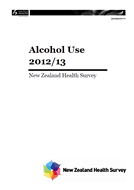Published online:
04 February 2015

The alcohol use report presents the key findings from the 2012/13 New Zealand Health Survey about alcohol use, misuse and alcohol-related harm among New Zealand adults aged 15 years and over.
The following topics are covered:
- patterns of alcohol consumption
- alcohol use by pregnant women
- alcohol availability and use.
Summary of key findings
Patterns of alcohol consumption
- In 2012/13 most adults had consumed alcohol in the past 12 months, typically doing so in their home or in another’s home. Most drinkers made a point of eating always or most of the time when they drank alcohol.
- A third of drinkers drank alcohol regularly: at least three to four times a week. Half of drinkers had drunk to intoxication at least once in the past 12 months, with a much smaller percentage reporting drinking to intoxication at least weekly.
- Drinkers reported a range of risky behaviours while drinking. Drinking and driving was most commonly reported, with one in six drinkers who drove in the past year having driven while feeling under the influence of alcohol.
- Drinkers experienced a range of harms as a result of their own drinking. Harm to physical health was the harm most commonly reported. A range of harms due to someone else’s drinking were reported. Violent harms were the most commonly reported harm resulting from someone else’s drinking.
Alcohol use by pregnant women
- In 2012/13 about one in five women who were pregnant in the last 12 months drank alcohol at some point during their most recent pregnancy. Of these women the majority reported past-year risky drinking.
- Most women who were pregnant in the last 12 months altered their drinking behaviour leading up to and during pregnancy. More than two-thirds of women who were pregnant in the last 12 months and who had ever drunk alcohol received advice not to drink during pregnancy.
Alcohol availability and use
- Alcohol outlets are within a short driving distance for most New Zealanders. Off-licence alcohol outlet density is greatest in the most deprived areas.
- Hazardous drinkers living within the most deprived urban areas are more likely to live within two minutes’ drive of multiple off-licence alcohol outlets than hazardous drinkers living in the least deprived urban areas.
Data tables (Excel, 2 MB) are available with results from this publication.
If you have any queries please email [email protected]
Previous reports
Reports from previous years are available in the Library Catalogue.
